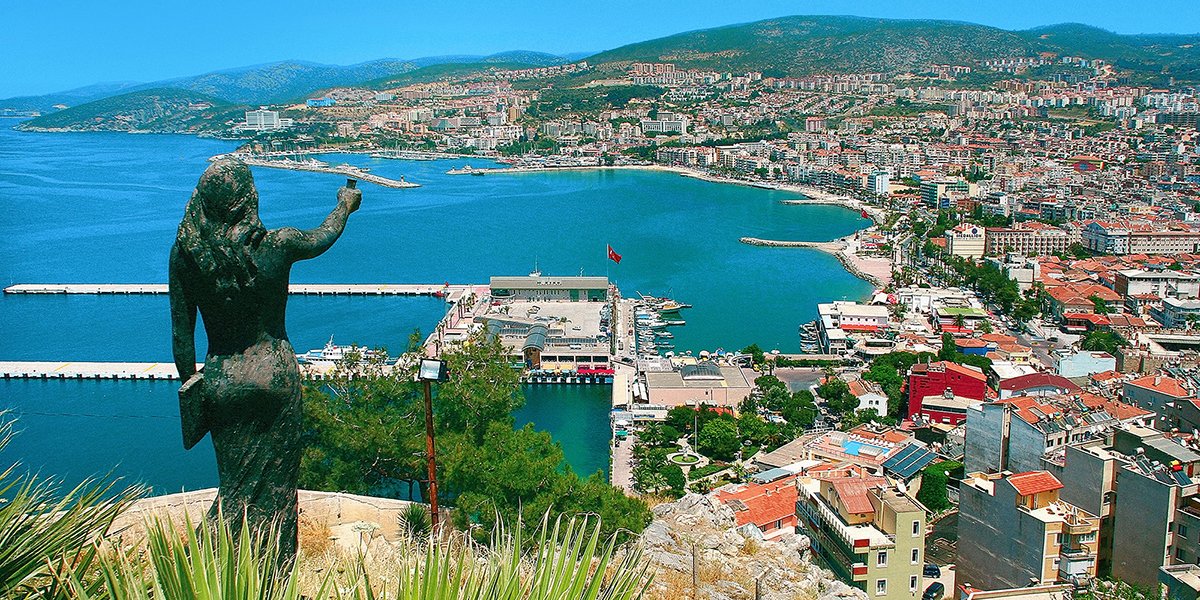Cesme
 Cesme, lying approx. 80 km west of Izmir, it's probably the first real one, Turkey's standard resort starting a series of such swirls extending further south, and then east along the Mediterranean coast. Tourists come here, to sunbathe and bathe in the sea, because the 14th-century Genoese fortress is not so attractive (in their opinion), so that in order to see it, you should choose here. Besides, there have never been so many foreign fans of roasting in the sun, as in other resorts on the Aegean Sea, until tourist guides paid attention to this place. Still in years 80. Cesme was the domain of the Turks from Izmir and the surrounding area. The time of prosperity began in the years 60., when the families of Izmir cream began to visit the poor fishing village, discovering the beautiful countryside and the mountainous Greek island of Chios, lying near the shore of Cesme. Unfortunately (for Turkish regulars, and recently even the Greek) also the author of this guide would like to draw the reader's attention to this little one, interesting place. We will visit a few monuments here, and, as it were, we will bathe in the sea. We can also bathe in the sea, and, as it were, visit a few monuments. Anyway, if we have some time up our sleeve, it wouldn't hurt to go here for one afternoon.
Cesme, lying approx. 80 km west of Izmir, it's probably the first real one, Turkey's standard resort starting a series of such swirls extending further south, and then east along the Mediterranean coast. Tourists come here, to sunbathe and bathe in the sea, because the 14th-century Genoese fortress is not so attractive (in their opinion), so that in order to see it, you should choose here. Besides, there have never been so many foreign fans of roasting in the sun, as in other resorts on the Aegean Sea, until tourist guides paid attention to this place. Still in years 80. Cesme was the domain of the Turks from Izmir and the surrounding area. The time of prosperity began in the years 60., when the families of Izmir cream began to visit the poor fishing village, discovering the beautiful countryside and the mountainous Greek island of Chios, lying near the shore of Cesme. Unfortunately (for Turkish regulars, and recently even the Greek) also the author of this guide would like to draw the reader's attention to this little one, interesting place. We will visit a few monuments here, and, as it were, we will bathe in the sea. We can also bathe in the sea, and, as it were, visit a few monuments. Anyway, if we have some time up our sleeve, it wouldn't hurt to go here for one afternoon.
We can get to Cesme very easily. First, you need to get to a place called Uckuyular (6 km southwest of Konak Meydani), where the dolmus leaves to the town from. We can get there by bus no 169 from stops along Cumhuriyet Bulvari.
From Uckuyular dolmus and buses to Cesme depart very often (2 USD, ok. 1 time. 15 min). We can take the bus back, which is heading to the terminal in Izmir, and get off somewhere on the way in the city center.
We have several sights in Cesme. Undoubtedly, the most important is the 13th-century Genoese fortress surrounded by a ring of double walls. It was taken over from Italians and restored in 1508 r. by Bejazid 11. Later it served mainly to control the coast against the attempts of the Knights Hospitaller present nearby (they were based on the island of Rhodes). The fortress now houses a museum, open every day (except Mondays) in hours. 8.30 – 12.00, 13.00 – 17.30, introduction: 1 USD. Finds excavated at the site are presented here, where the ancient city of Eritrea once lay, as well as small collections of Turkish weapons. Another monument in Cesme is the Ottoman caravanserai built in 1528 r. by Suleiman the Magnificent, and two seventeenth-century mosques (Haci Memię Mosque and Haci Mehmet Mosque) they attract attention with their simple forms. To the north of the main square there are ruins of the 19th-century church of Ayios Haralambos, a 1 km to the west of them (near the stop, from where the dolmus leaves to Izmir) we find the remains of an ancient stadium. In turn, approx. 500 m south of them lie the foundations of an ancient theater. The city is famous for its naval battle, which took place in the 18th century. in the surrounding waters. Well 7 July 1770 r. the Russian fleet surprised Ottoman ships in a bay near Cesme and destroyed them completely. The battle revealed the hero Gazi Hasan Pasha on the Turkish side, who broke with his sinking ship through the Russian lines, he fled the place of defeat and fought the Russians the next day. However, only the coming year brought him a victory over the Russians near Lemnos.
Sandy beaches are approx. 5 km to the north and south of the town. The best of them are Boyalik and Ilica, to which we get dolmusz. From the port, you can sail to the Greek island of Chios (there and back: ok. 45 USD). There are many different categories of hotels and restaurants in Cesme, so if we decide to stay here overnight, probably even in the season we will find something for ourselves.